Lee Westwood – Driving Machine
No one in golf drives it any better than Europe’s No.1 – and shoulder ‘stability’ throughout the swing is the key by Pete Cowen.
Looking at the sequences below, my eye is automatically drawn to the way in which Lee’s shoulders control the entire motion. From the set-up, he maintains his arm and club position to the top with the wonderful movement of his upper body. At the top of the swing both the left arm and the shoulders are at 45 degrees (or thereabouts), and as we have highlighted here he creates a distinct right angle between his left arm and the clubshaft – huge leverage and power there.
Lee Westwood – Driving Machine
Looking down the line, again it all matches up: the left arm and the shoulders are at that 45-degree angle while the clubface matches the wrists. From here, there’s no compensation necessary on the way back to the ball – Lee sets it all up on the way back for the delivery on the way down to be perfect.
Let me give you an analogy that underpins my teaching philosophy: think of the body as the engine, the arms and the club as the steering wheel. Ideally, the thing you want your engine to do is purr – never miss a beat. (That’s Lee Westwood every time. He has worked hard on his fitness and now he’s reaping the benefits with a powerful body action.) But no matter how good the engine or the steering may be, unless the ‘linkage’ between the two components is up to scratch, you’re going nowhere. In the golf swing, that linkage is the shoulder motion – if the shoulders are sound and stable, the transfer of energy down into the golf club will be sound and stable. That’s a trademark of the Pete Cowen method.
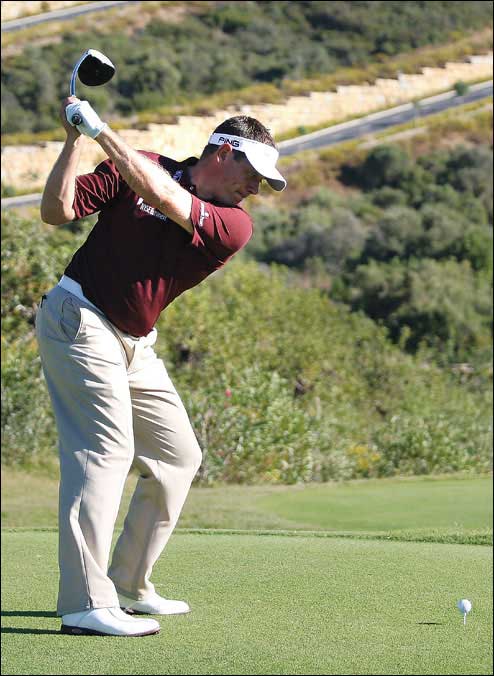
Lee Westwood – Driving Machine
Left arm matches up with the plane of the shoulder turn. At the same time, shoulder stability is the key to Lee’s consistency.
Lee Westwood – Driving Machine
The problem every golfer has to contend with is the fact that the shoulder unit is hyper mobile – it can go all over the place. There are only so many moving parts to control in making a swing. The wrists move in four ways (up and down, back and forwards). Your elbows do one thing (up and down). But your shoulders can go anywhere they want. So what you as a player have to do is learn how to stabilise their motion – to hold them in position and transfer energy with shoulder stability.
The shoulders themselves are ‘linked’, left and right, and you will see in the following sequences that Lee achieves this beautifully.What’s more, the shoulders stabilise the motion all the way through to the finish. There’s no ‘looseness’. Which is why the energy is passed so efficiently to the clubhead.
Lee Westwood – Driving Machine
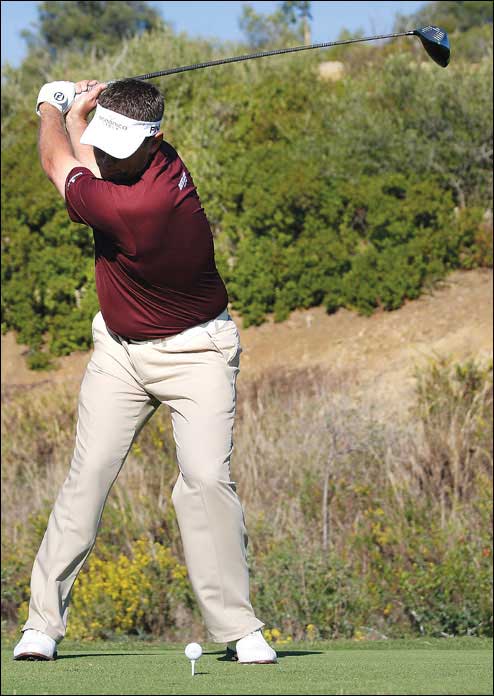
‘Loaded’ backswing is reminiscent of Hogan- superb lower body action, feet ‘planted’, utilising ground force to add to the coil.
To summarise, the role of the body is thus:
• In the backswing the body helps to ‘load’ the power and position the club (as you see above)
• Starting the downswing, the shoulder stability helps to reposition the club for delivery into the ball
• Through impact, the body turns to square the clubface and stabilise impact
• Finally, the body helps to slow the club down. Watch a good player, and you’ll see that as the body slows to a stop, the arms and the club stop with it – all totally under control.
Lee Westwood – Driving Machine
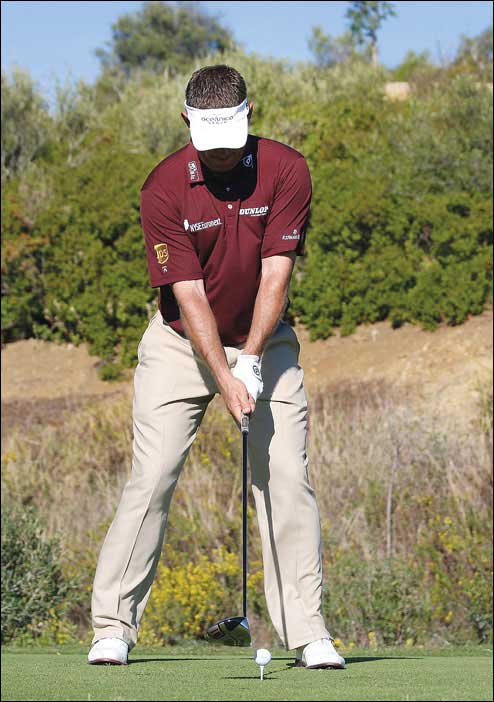
The base is set and strong – i.e. hips level, great shoulder angle, arms hanging ‘long’ and comfortable. A classic set-up for a penetrating drive.
Lee Westwood – Driving Machine
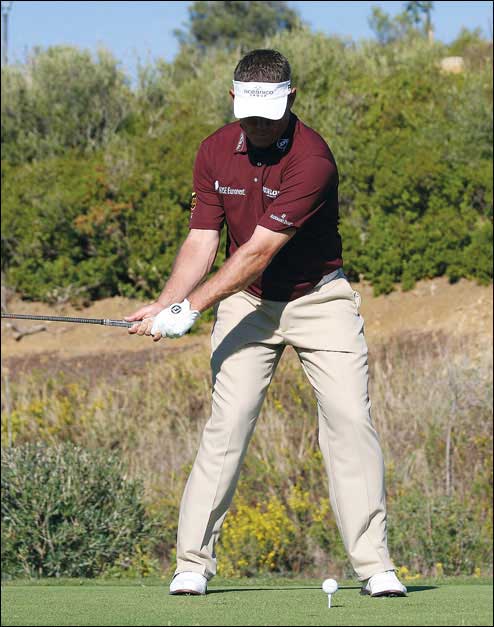
As he moves the club away, Lee is ‘loading’ the swing perfectly, the left arm and the shaft creating terrific width. Importantly, he has not ‘set’ the club too early with excessive wrist action.
Lee Westwood – Driving Machine

Wrists are now just starting to set, which means he is starting to get some speed into the clubhead. The body action is sound – there’s no unnecessary movement as he continues to rotate his upper body over the stability of his hips and legs.
Lee Westwood – Driving Machine
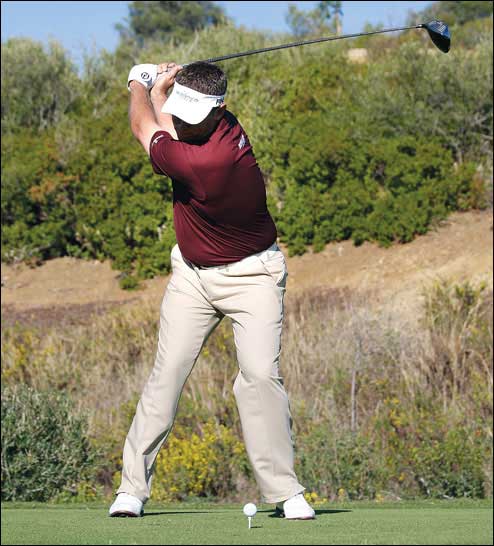
What I really like about this position at the top is the three-dimensional hip depth. Lee has not moved laterally – this is rotation of the hips. You can see the power in the ripples in his shirt – he is ‘loading’ from the left hip to the right shoulder. This is reminiscent of the Hogan model – a lot of people would regard this is a reverse pivot, but it’s not. It’s a three dimensional rotation against a stable right leg – this swing is loaded (I’d give it 7 out of 10!).
Lee Westwood – Driving Machine
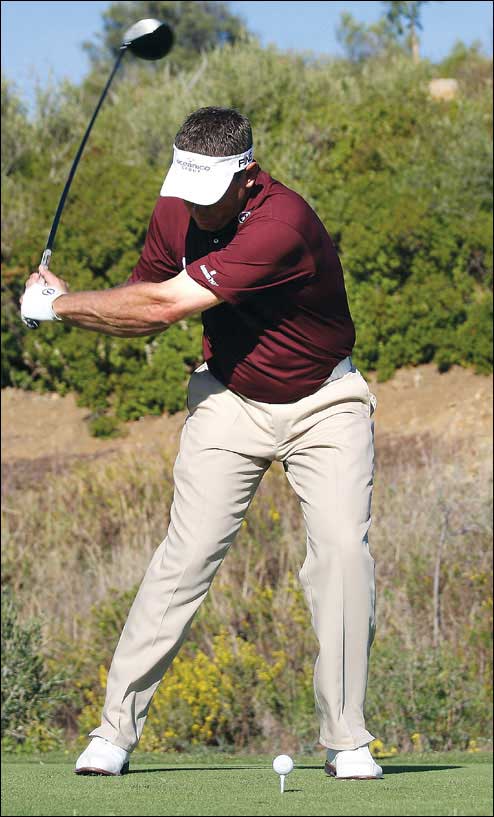
What I call the ‘left post’ – the position of the left leg as he moves into the transition is perfect, really. He has pressure into his right leg and from here he has all the time in the world to use that stored-up energy. The hips can be the biggest killer in the golf swing, but they’re also one of the biggest providers of power, so you have to learn to use them correctly.
Lee Westwood – Driving Machine
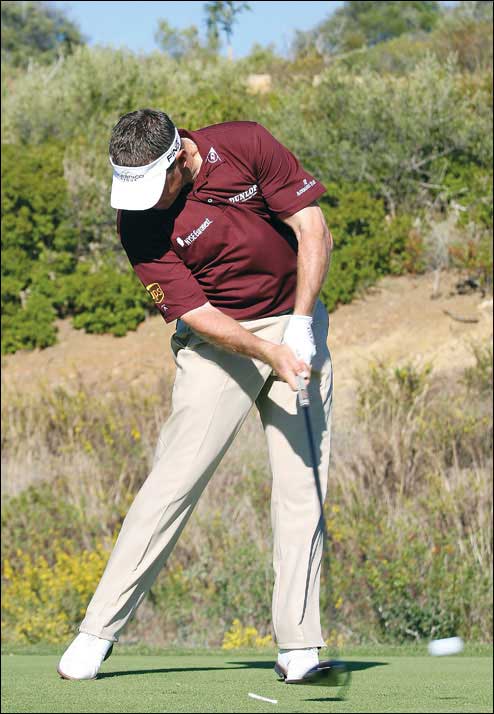
The position of the left arm obviously draws your eye here, and more on that in a moment. You can see that the left shoulder has pulled away from the head as Lee uses the rotational power of the upper body to square the clubface. He is using leverage from the left foot to the left shoulder – that’s where real power comes from.What a lot of people don’t realise is that Lee’s left arm is naturally bent, which helps to explain why he is such a good driver of the ball – in other words his anatomy actually helps him to hit a power fade. And just look at the head position – it’s ‘behind the ball turning’. Lee never gets ahead of it., and as a result there’s a massive energy transfer as the ball is thrown down the line.
Lee Westwood – Driving Machine
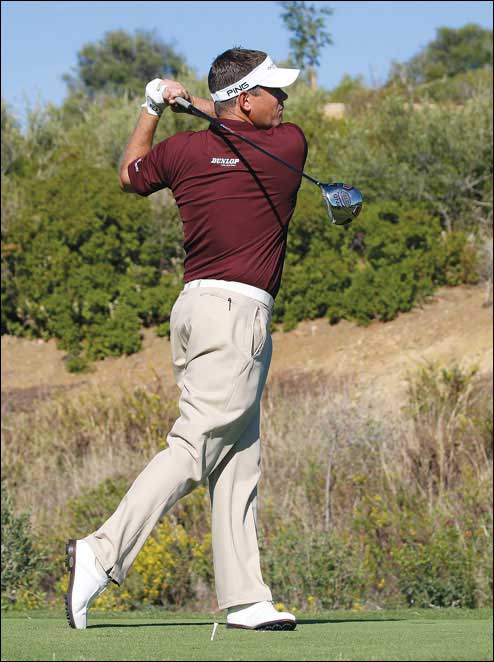
Just looking at this still photo you can tell that Lee’s shoulders and body action remain in total control of the swing all the way to the finish. The shoulders arrive level, the clubshaft is behind the neck. Yet again, the engine is purring all the way – and that’s the secret to the efficient transfer of energy to the ball.
Lee Westwood – Driving Machine
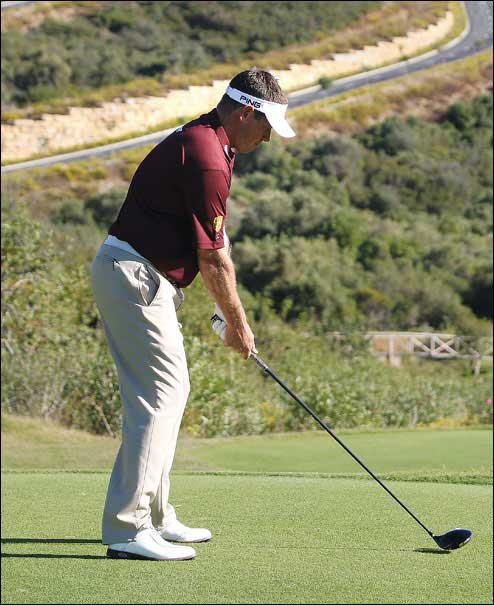
Arms and shaft at a good angle (I refer to the ‘sweep’ angle from right shoulder down right arm to the shaft – and that’s all good here). Head position/ general posture is all excellent. This is the result of the hard work Lee has being doing in the gym with his physical trainer, Steven MacGregor. As Lee mentioned in the last issue, he works on strength and flexibility exercises that enable him to recreate a two-second explosion – which he may repeat only 40 times in a a round of golf. Right now, he’s at the peak of his fitness.
Lee Westwood – Driving Machine
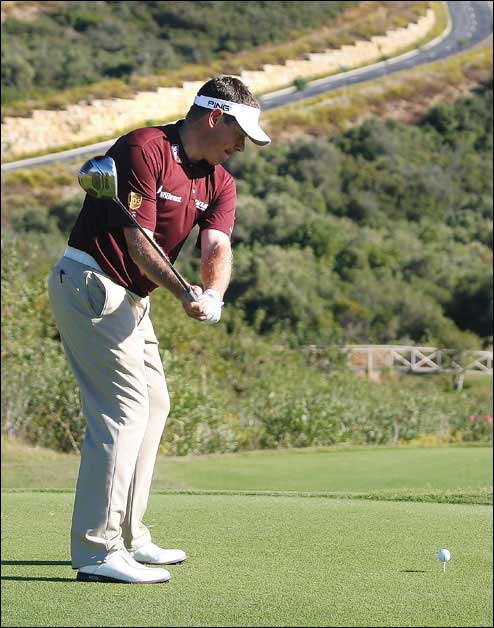
The left arm position here is perfect, elbows level – as you can see they are in many of the key positions in the backswing. That’s a massive plus with the driver. You can see the elbows retain their relationship in the third and fourth frames, it’s a constant. I mentioned earlier that I use a 45 degree angle reference at the top of the swing – adding it here illustrates Lee is on the right track.
Lee Westwood – Driving Machine

As his wrists set the club up, and the clubhead gathers speed, we look for the shaft to go through the bicep – we don’t want to see it too ‘deep’, or behind him. As he then reaches the top I don’t want to see the hands get too far behind the right shoulder – in fact, if I was being a 100% critical, I might say I’d like to see the hands a little more above the tip of the right shoulder in the next frame (tho’ it might just be the angle at which the photo is taken). But that’s just me being pedantic – hey, I’m a Yorkshireman!
Lee Westwood – Driving Machine
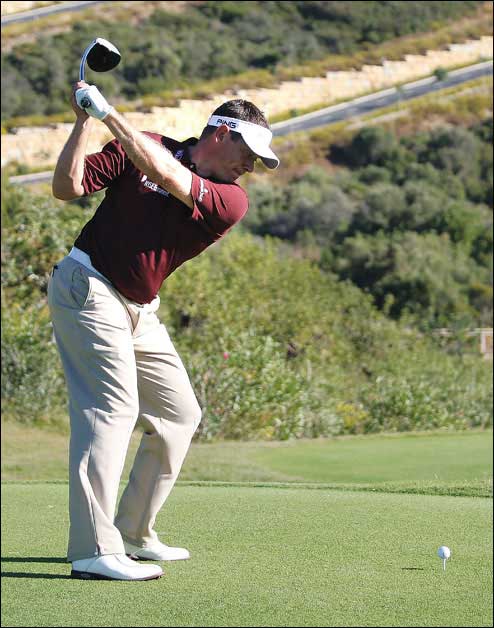
To all intents and purposes, the right arm and right shoulder position is fantastic. We’ve been working hard on this lately. For me, right arm stability is everything in the swing. We could draw a triangle shape in here, it’s textbook. The left arm matches up with the plane of the shoulders, and look at how the clubface is in tune with the back of the left hand while the shaft is starting to flex and ‘load’.
Lee Westwood – Driving Machine
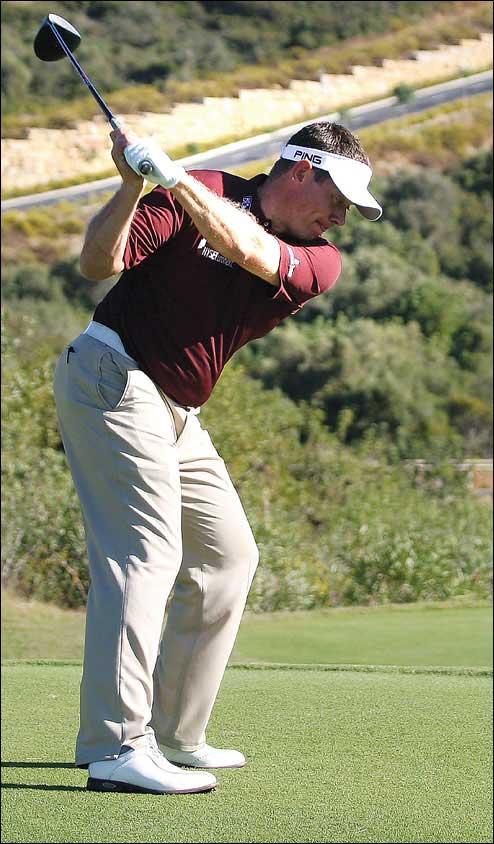
As he starts down, look at the way the left arm and the shaft are lining up – what I call ‘shallowing the loft’. Lee never gets the clubface shut. If you look at the clubface at the top of the swing and then again here, you can see the club has retained the perfect loft: it is not de-lofted, it is not changed from the position at the top of the backswing. This is controlled by the right shoulder working down and not forwards before it then rotates hard.
Lee Westwood – Driving Machine
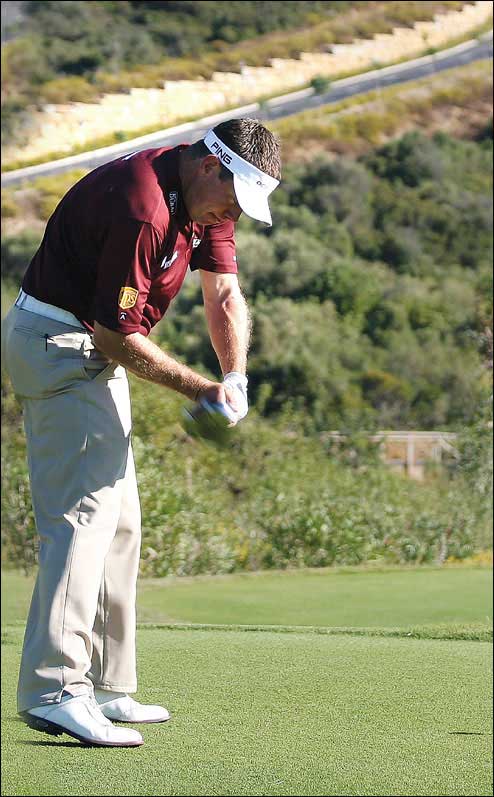
A perfect pre-delivery position – the club is neither too far behind him or too much in front. Only now does the right elbow get below the left – a natural hitting position as a player prepares for impact. He squares it all up with the hips and shoulders turning in the very next frame.
Lee Westwood – Driving Machine
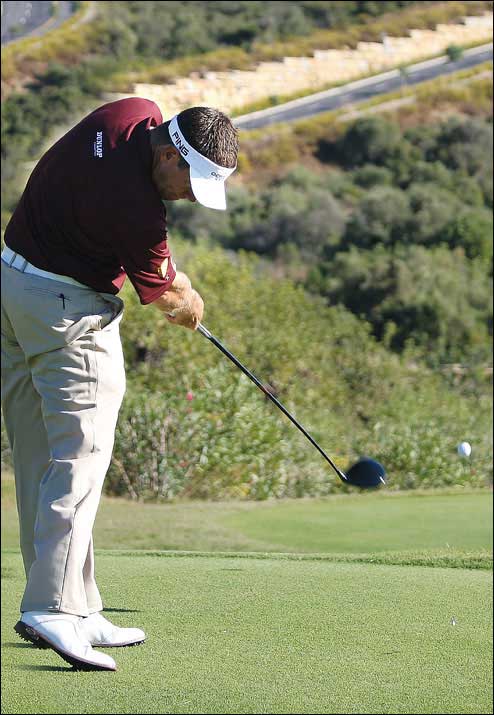
Lee moves to determine the shot with great footwork – i.e. his weight is going in the direction in which he wants to fire the shot. You “keep the ground”, as I constantly remind my players. If you lose the ground then you will lose all control of what’s happening above the ground. (You see the same thing with Rory).
Lee Westwood – Driving Machine
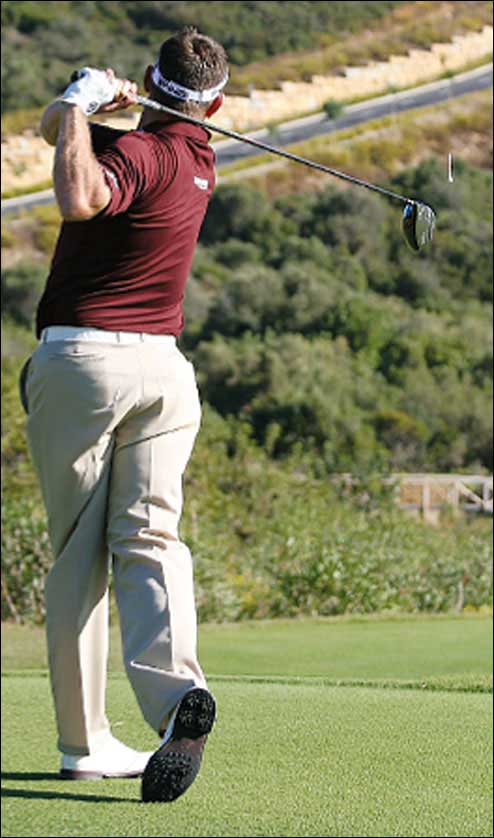
Look how far left of the target Lee’s body is facing at the finish – the result of a totally committed rotation and release through the ball. Remember, your hand arc must be to the left of the target line – that’s a point many amateurs fail to get to grips with (hence they ‘chase’ the ball down the target line, which costs them speed). Lee’s whole body is rotated left of the play line. He turns left, the ball goes straight, and he wraps it all up in perfect balance.
Originally posted in 2010